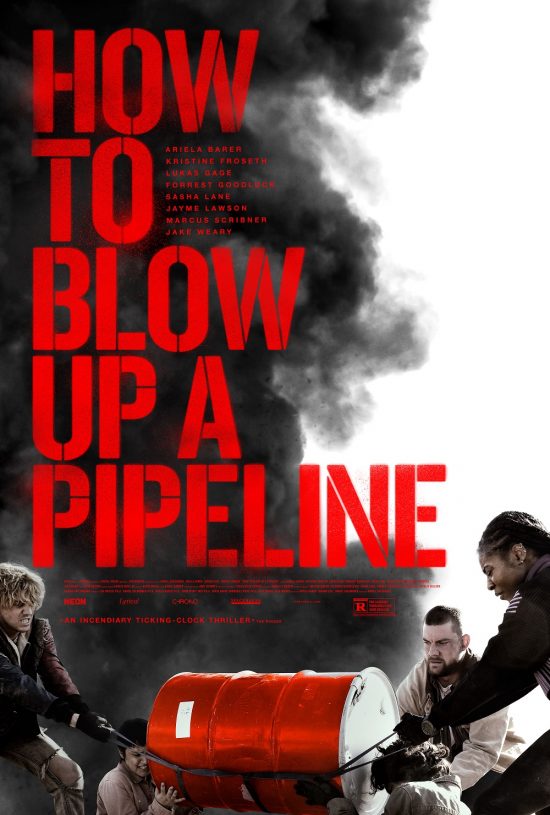Review: How to Blow Up a Pipeline – “A gripping and exhilarating ride.”

Star, producer and writer Ariela Barer in How to Blow Up a Pipeline. Courtesy of NEON
Just last month the Secretary-General of the United Nations, António Guterres, acknowledged an updated report on climate change, one that was formulated using findings from hundreds of scientists. “The climate time-bomb is ticking,” he remarked, adding, “Humanity is on thin ice – and that ice is melting fast.” Indeed the report was dire, its findings showing the planet, and the consequences of our pollution of it, are worse than we could have imagined. And so, Neon’s release of eco-thriller How to Blow Up a Pipeline seems even more timely than ever before.
Director Daniel Goldhaber optioned Andreas Malm‘s book of the same name after reading it during COVID lockdown. Says the director in a statement, “We were feeling creatively and politically powerless, but the book’s ideas electrified us. Andreas claims that, throughout history, property destruction has been a critical tactic in the fight for social justice.” While the manifesto itself doesn’t teach you how to actually use explosives on a pipeline, it argues that because of the urgency of the climate situation there is justification in disrupting the fossil fuel industry in this way. For the details, Goldhaber worked with counterterrorism experts as well as pipeline engineers. What results is an exciting, realistic feeling thriller that is deeply resonant.
Writing alongside Jordan Sjol and Ariela Barer (who also stars), Daniel Goldhaber creates a diverse cast of characters from all different backgrounds, driving home the point that climate change is something that affects everyone. This group of environmental activists recognize they’ll be labelled as eco-terrorists for their actions, yet How to Blow Up a Pipeline ensures that the audience remains empathetic to their cause. While the film immediately puts you in the middle of the group’s assembly, as they all gather in a remote spot of west Texas, throughout the film we are more properly introduced to its players and the reasons why they are willing to risk everything for change.
Xochitl (Barer) lost her mother during a severe heat wave. Her good friend Theo (Sasha Lane) is dealing with severe illness, a consequence of having grown up beside an oil refinery and constant exposure to its pollutants. Michael (Forrest Goodluck) sees what the fossil fuel industry is doing to the Indigenous land and how his people are treated by the newcomers working there. Each and every person involved, which also includes characters played by Kristine Froseth, Jayme Lawson, Marcus Scribner, Jake Weary and a standout Lukas Gage, is intensely motivated to bring about environmental change; just as each and every member of this excellent cast seems dedicated to bringing this film to life.
And this group has things planned down to every tiny detail. It’s how it unfolds that often makes How to Blow Up a Pipeline feel like the heist movie of yesteryear. That feeling is intensified by the dusty, gritty landscape captured by director of photography Tehillah de Castro on 16mm which adds to the grainy texture of the film. Of course like any good heist movie, nothing goes exactly according to plan but each new situation, each new twist, only serves to amp up the tension in this already taut thriller. The largely electronic based score from Gavin Brivik helps keep your heart pounding, a perfect complement to this modern day tale.
From its opening sequence you can tell that How to Blow Up a Pipeline is going to be a gripping and exhilarating ride. It never disappoints, and even though it’s only April, I’ll be surprised if this film doesn’t make many ‘best of’ lists for 2023. It will certainly be on mine. Director Daniel Goldhaber puts his foot on the gas and doesn’t let up, never wasting a minute of his 104 minute runtime. The sense of urgency he brings to the screen is indeed only magnified by the realization that what these characters are fighting for is, in fact, rooted in reality for all of us.
Goldhaber’s film, topical and timely as it is, can’t help but make you wonder what radical action truly is needed to evoke environmental change. You feel for this generation of young people who can’t help but feel powerless. How to Blow Up a Pipeline shows its characters taking some of that power back, where actions speak louder than words. And for each action they leave behind a simple explanation, “If the law will not pursue you, we will.” The climate crisis is here, the fight for our future is here. While this act of sabotage depicted in How to Blow Up a Pipeline is indeed radical, it drives home the critical idea of how close to the edge we are, how urgent the need for change truly is, and poses the question of what we are willing to do in order to ensure our survival.
How to Blow Up a Pipeline premiered at the Toronto International Film Festival September 2022. It is released in North American theatres April 7th, and in the UK April 21st.












I blocked DC-MD Beltway with others in Oct in nonviolent action (of sitting) to get attention for our government to DeclareEmergency) by disrupting. I really liked the movie, especially as it shows WE DID the BETTER action.